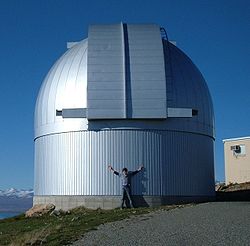
Microlensing Observations in Astrophysics
Encyclopedia

New Zealand
New Zealand is an island country in the south-western Pacific Ocean comprising two main landmasses and numerous smaller islands. The country is situated some east of Australia across the Tasman Sea, and roughly south of the Pacific island nations of New Caledonia, Fiji, and Tonga...
and Japan
Japan
Japan is an island nation in East Asia. Located in the Pacific Ocean, it lies to the east of the Sea of Japan, China, North Korea, South Korea and Russia, stretching from the Sea of Okhotsk in the north to the East China Sea and Taiwan in the south...
, led by Professor Yasushi Muraki of Nagoya University
Nagoya University
Nagoya University is one of the most prestigious universities in Japan. It can be seen in the several rankings such as shown below.-General Rankings:...
. They use microlensing
Gravitational microlensing
Gravitational microlensing is an astronomical phenomenon due to the gravitational lens effect. It can be used to detect objects ranging from the mass of a planet to the mass of a star, regardless of the light they emit. Typically, astronomers can only detect bright objects that emit lots of light ...
to observe dark matter
Dark matter
In astronomy and cosmology, dark matter is matter that neither emits nor scatters light or other electromagnetic radiation, and so cannot be directly detected via optical or radio astronomy...
, extra-solar planets, and stellar atmosphere
Stellar atmosphere
The stellar atmosphere is the outer region of the volume of a star, lying above the stellar core, radiation zone and convection zone. It is divided into several regions of distinct character:...
s from the Southern Hemisphere
Southern Hemisphere
The Southern Hemisphere is the part of Earth that lies south of the equator. The word hemisphere literally means 'half ball' or "half sphere"...
. The group concentrates especially on the detection and observation of gravitational microlensing
Gravitational microlensing
Gravitational microlensing is an astronomical phenomenon due to the gravitational lens effect. It can be used to detect objects ranging from the mass of a planet to the mass of a star, regardless of the light they emit. Typically, astronomers can only detect bright objects that emit lots of light ...
events of high magnification, of order 100 or more, as these provide the greatest sensitivity to extrasolar planets. They work with other groups in Australia
Australia
Australia , officially the Commonwealth of Australia, is a country in the Southern Hemisphere comprising the mainland of the Australian continent, the island of Tasmania, and numerous smaller islands in the Indian and Pacific Oceans. It is the world's sixth-largest country by total area...
, the United States
United States
The United States of America is a federal constitutional republic comprising fifty states and a federal district...
and elsewhere. Observations are conducted at New Zealand's Mt. John University Observatory
Mount John University Observatory
Mount John University Observatory , is New Zealand's premier astronomical research observatory. It is situated at ASL atop Mount John at the northern end of the Mackenzie Basin in the South Island, and was established in 1965...
using a 1.8 m (70.9 in) reflector telescope built for the project.
Planets discovered
The following planets have been announced by this survey, some in conjunction with other surveys.| Planet Planet A planet is a celestial body orbiting a star or stellar remnant that is massive enough to be rounded by its own gravity, is not massive enough to cause thermonuclear fusion, and has cleared its neighbouring region of planetesimals.The term planet is ancient, with ties to history, science,... |
Date announced |
|---|---|
| MOA-2009-BLG-387L MOA-2009-BLG-387L MOA-2009-BLG-387L is a red dwarf in the Sagittarius constellation that is host to the planet MOA-2009-BLG-387Lb. The star is estimated to be nearly 20,000 light years away and approximately one fifth the mass of the Sun, although large confidence intervals exist, reflecting the uncertainties in... |
February 2011 |
| MOA-2007-BLG-400Lb MOA-2007-BLG-400Lb MOA-2007-BLG-400Lb is an extrasolar planet located approximately 20000 light-years away in the constellation of Sagittarius, orbiting the star MOA-2007-BLG-400L. This planet was detected on September 18, 2008 by the gravitational microlensing by Dong. It has mass between 50% to 130% of Jupiter and... |
September 18, 2008 |
| MOA-2007-BLG-192Lb MOA-2007-BLG-192Lb MOA-2007-BLG-192Lb, occasionally shortened to MOA-192 b, is an extrasolar planet approximately 3,000 light-years away in the constellation of Sagittarius. The planet was discovered orbiting the brown dwarf or low-mass star MOA-2007-BLG-192L. At a mass of approximately 3.3 times Earth, it is one of... |
May 30, 2008 |
| OGLE-2003-BLG-235/MOA-2003-BLG-53b OGLE-2003-BLG-235Lb OGLE-2003-BLG-235Lb/MOA-2003-BLG-53Lb is an extrasolar planet discovered in April 2004 by the OGLE and MOA collaborations. Its high mass indicates that it is most probably a gas giant planet similar to Jupiter. It is located around 4.3 AU away from its parent star.- External links :***SPACE.com: ... |
April 15, 2004 |
See also
- Optical Gravitational Lensing ExperimentOptical Gravitational Lensing ExperimentThe Optical Gravitational Lensing Experiment or OGLE is a Polish astronomical project based at the University of Warsaw that is chiefly concerned with discovering dark matter using the microlensing technique. Since the project began in 1992, it has discovered several extrasolar planets as a side...
or OGLE, a similar microlensing survey - List of extrasolar planets

